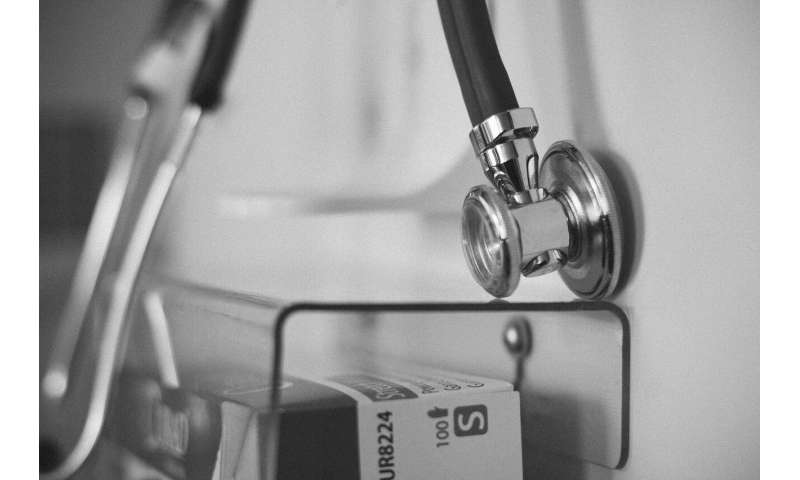Vaccines are coming. But inside the ICU at this hospital, the COVID-19 pandemic is far from over.

Just beyond a short yellow barrier reminding Rush Copley intensive care unit staff which rooms are for COVID-19 patients and which are “clean,” a masked team of doctors, pharmacists and other caregivers meets in a corner to review each critical care patient’s needs.
They calmly discuss the virus patients, each one behind tightly-closed, curtained glass doors nearby, but there’s an urgency to the team’s work. In the previous six days in this ICU, five COVID-19 patients died.
It has taken a toll on nurses like Christine Jewell. By now she is used to the routine of pandemic life, but she becomes emotional talking about her patients who have died alone.
“It’s honestly been one of the worst things I’ve dealt with in my career,” Jewell said. “Seeing people die alone is really emotional for me. It’s really hard. I just can’t imagine my family member or myself going through that.”
Nine months into the pandemic Rush Copley staff have settled into the logistics of COVID-19 care. But for the doctors and nurses working with virus patients every day, the pandemic grind is far from over, despite the promise of the new vaccine.
On a recent weekday morning in the hospital, the virus shows few signs of waning. On the hospital’s second floor, the largest COVID-19 unit has just one free bed. Hospitalizations have dropped in recent days, but staff are bracing for a post-Thanksgiving bump that could materialize three to four weeks after the holiday, and another bump after Christmas and the new year.
Rush Copley hit record high numbers of COVID-19 patients during this most-recent wave of the pandemic, though the patients often stay for less time than they did in the spring in part because the doctors now know more about treatment, Chief Operating Officer Mary Shilkaitis said.
The hospital hit capacity Nov. 9 and for several hours had to notify the state that ambulances would be diverted to other hospitals, something Shilkaitis could not recall ever happening in her years working at the hospital. Rush Copley also postponed some elective surgeries in those hours.
That day, doctors treated 87 COVID-19 patients at Rush Copley. In the spring, the highest number of virus patients didn’t exceed 70, Shilkaitis said.
Thursday, Rush Copley, Aurora’s largest hospital, allowed a newspaper reporter and photographer rare pandemic access to the emergency room, a COVID-19 unit and the intensive care unit. At that time, across all hospitals in Kane and DuPage counties, 84.7% of intensive care unit beds were filled, as were 88.1% of medical and surgical beds, state data shows.
The state’s warning threshold for hospital space is triggered when more than 80% of available beds are filled across a region. By Sunday in Kane and DuPage counties fewer intensive care and medical and surgical beds were filled, with 75.5% of ICU beds occupied and 81.2% of medical and surgical beds.
Even as Rush Copley was busy with COVID-19 and other patients, parts of the building had a relaxed, deliberate feel. In the places where virus patients were treated, doors stayed closed, shutting out the typical sounds of caregivers, patients and medical machines in each room.
Rush Copley’s emergency department was quiet that morning. Along a hallway off the main waiting room, a row of empty chairs was designated for potential COVID-19 patients, one of several virus precautions the emergency room has taken.
Emergency services medical director Christopher Hwang said he would enjoy the quiet while it lasted, because it could change quickly. At any moment the hospital could get a rush of ambulance runs and a full waiting room.
Unlike in the spring, when many potential patients stayed home from the hospital at all costs, he is now balancing COVID-19 patients with those experiencing heart attacks, strokes and other ailments. On top of that, he tries to keep his staff up to date on ever-changing virus protocols.
“It’s been the most challenging year, I think, of my professional career,” he said.
In another sign of the changing nature of the pandemic, the hospital’s ambulance bay, where early on tents were set up for screening potential COVID-19 patients, is now home to a tent serving as the hospital’s new monoclonal antibody clinic, where those less severely ill with the virus can get treatment. The hospital was waiting Thursday morning to hear whether the first person eligible for this type of treatment at Rush Copley would choose to receive it.
Upstairs, the largest COVID-19 unit at the hospital was expanded to its full 32-bed capacity and 31 beds were occupied, though the hospital also has other virus units. The unit was lined with closed wood doors, and staff moved purposefully about in masks and sometimes face shields. One donned a reusable, washable surgery gown as she prepared to enter a patient’s room.
Lined up under windows at the end of the hallway, lightly-used protective gear aired out inside labeled brown paper lunch bags. While staff may reuse some items that were worn only briefly, Mary Applequist, clinical manager of the unit, said they have enough protective gear to change the equipment regularly.
In the intensive care unit, Jewell entered the closed glass door of a COVID-19 patient’s room. She added a yellow surgical gown, goggles and purple gloves to the large mask and cap she already wore around the unit.
Patients filled nine of the 10 ICU beds the hospital had designated for COVID-19, though the unit had other space should more virus patients needing critical care arrive.
The ICU’s patient volume overall has been higher recently than typical, unit manager Dawn McQuality said. The unit typically sees more patients at the end of the year, in part because of flu season, and is now also serving patients who might have delayed care earlier in the pandemic and COVID-19 patients, she said.
No visitors are allowed in intensive care unit rooms, even for patients who are dying. The hospital has provided iPads so they can see and hear their family, but it often falls to staff like Jewell to be at their patients’ bedsides.
“Just try to stay with them,” Jewell said. “Hold their hand and let them know that it’s OK, and that they’re safe and that we’re with them.”
She feels lucky the intensive care staff are tight-knit and have supported each other, but it is heart-wrenching, she said. And exhausting.
Respiratory therapist Lisa Keller, too, is feeling the intensity COVID-19 has brought to her job. The hospital’s respiratory therapists focus on breathing for everyone from premature babies to geriatric patients, and for Keller, while the chaos of the early months has faded, the pandemic has worn on.
“I’m done,” she said. “But, I mean, I won’t stop until everybody’s healthy and we’re on our way to healing our nation and our area.”
On top of the job stress, she has her family to worry about. For months she has kept a strict decontamination regimen when she gets home from the hospital. When her 6-year-old requests hugs before she has completed the regimen, Keller’s response of simply, “covid,” is enough to warn her daughter off.
Keller’s family is used to the routine, but she said she and other therapists have had moments of breakdown in recent weeks, watching patients they’ve worked so hard to keep alive slip away.
The exhaustion has been felt in other parts of the hospital as well. Jenny Sipes, a nurse in the emergency room, said that even though as an emergency medicine nurse she signed up for a challenge, there is some mental exhaustion. She feels that she has the right protective gear and has been able to get rest, and she is inspired by efforts in the community to slow the virus’ spread. But, just as the community is tired of the pandemic, so are nurses, she said.
Hospital staffing levels have been affected because more staff have been out sick with COVID-19 or symptoms now than in the beginning of the pandemic, Shilkaitis said, though she said the hospital has worked, often successfully, to keep staff healthy. Among the steps the hospital can take in response is bringing in additional staff from temp agencies, though she has not had to do that often, she said.
The staff has developed ways to cope, and there are signs of levity in the hospital. Sipes, in the emergency room, finds inspiration in being part of a medical world rapidly changing as it learns more about the virus. In the COVID-19 unit, one nurse wore a surgical mask dotted with Santa Clauses and Christmas trees under her face shield.
A less busy unit at the hospital recently donated lunch to the second-floor COVID-19 unit and has loaned staff to help with tasks such as answering calls or checking vital signs, Applequist said. She is working with staff downtown through the Rush health system on a virtual wellness discussion for her employees.
The intensive care unit staff got a brief respite over the summer when cases dipped, McQuality said. Jewell copes by taking free online yoga and pilates classes offered through the hospital, and she takes walks on her lunch break and days off. Being with other ICU staff who know what it’s like also helps, she said.
And the new vaccine offers hope for many, though some staff and Shilkaitis cautioned it won’t be an instant fix. Thursday, Shilkaitis said the hospital was awaiting guidance on the details of distribution.
Hwang, the emergency room doctor, is anticipating the vaccine and happy it was developed so quickly. He is hopeful it soon will be widespread and cases will go down significantly by summer.
First, however, comes the winter. He anticipates a tough few months with the specter of the flu lingering on top of the pandemic.
Source: Read Full Article



